The Fever of 1721
Air Date: Week of September 9, 2016
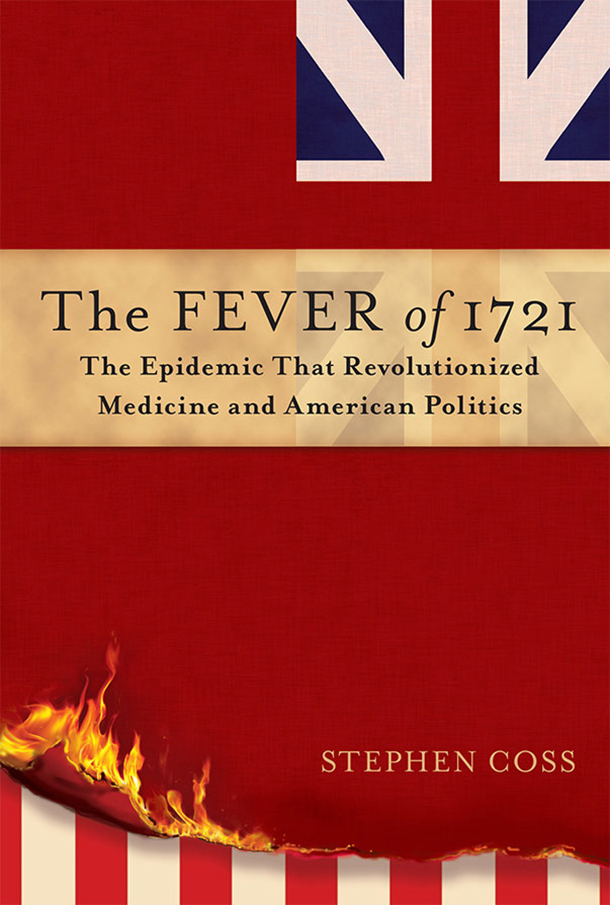
The Fever of 1721 is Stephen Coss’s first book. (Photo: courtesy of Stephen Coss)
The worst smallpox epidemic in Boston history was a turning point for control of the disease in the Massachusetts Bay Colony. According to Stephen Coss, author of The Fever of 1721, it also helped set the stage for the American Revolution and freedom of the press. Coss tells host Steve Curwood how the knowledge of a slave, the epidemic and political unrest influenced the lives of Cotton Mather, Benjamin Franklin, and an influential Boston physician, Zabdiel Boylston.
Transcript
CURWOOD: It’s Living on Earth, I’m Steve Curwood. Western medicine can be woefully behind the wisdom of ancient civilizations and tribes, as author Stephen Coss reveals in his book about the smallpox epidemic in Boston back in 1721. He tells how the fight in Boston to tap Asian and African understanding of smallpox inoculation also played a major part in fomenting the American Revolution, launched a combative free press along with the career of Ben Franklin, and also advanced science.
Today, with our understanding of infection and hygiene, the idea of squirting pus into an open wound sounds repellant – to say nothing of dangerous. Yet it was this very procedure that saved lives during the severe smallpox outbreak chronicled in “The Fever of 1721”. This swashbuckling tale of how Bostonians finally accepted inoculation also highlights a pirate chasing ship, and the wisdom of Onesimus, a slave owned by Cotton Mather of Salem witch trials infamy. Stephen Coss joins us to now. Welcome to Living on Earth.
COSS: Thank you, Steve.
CURWOOD: So, where did the idea for this book come from?
COSS: Well, the original idea came from a desk calendar that was essentially a fact a day calendar from my wife and kids. And as I thumbed through this calendar which I noticed the event I ended up writing about, the June 1721 inoculation experiment in Boston where a doctor named Boylston conducted what turned out to be the first inoculation experiment in western medicine. And I saw from that one little calendar page that it had been suggested by Cotton Mather, whom I had always thought of as the bad guy from Salem, and I had no idea there was any other dimension to him so that got me going.
CURWOOD: So, we've got a number of things are coming together here in your story of 1721. Let's talk about smallpox and the medical history here. And first question actually, what is inoculation?
COSS: That is a very good first question because a lot of people think inoculation and vaccination are the same thing when they're really not. Inoculation preceded vaccination, and inoculation involved taking smallpox pus from someone who was broken out in the disease and implanting it in an incision made in the arm, usually the arm of someone who had never had the disease, and the whole idea was to give the person who was inoculated a mild survivable case of the disease which would then, after they recovered, render them immune to any further infection.
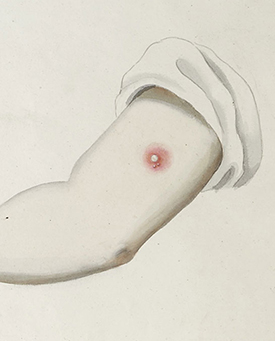
Day 5 of a 30-day watercolor series depicting the progression of a sore from smallpox inoculation, painted by George Kirtland in 1802. (Photo: George Kirtland, Wellcome Images)
CURWOOD: And remind us today of how deadly smallpox was and why this is such an important turning point.
COSS: Yeah, absolutely. Smallpox was until it was finally eradicated, the deadliest disease in the world. When smallpox came to a town like Boston, generally speaking, everyone who hadn't had it and was exposed to it would get it. In terms of those who got it, depending upon the population, it could go anywhere from 30 percent fatalities to ... There are cases with some Native American populations that had never experienced it at all where the fatality rate was approaching 90 percent.
CURWOOD: And I gather it's not a fun way to go.
COSS: No, it was an agonizing way to go. It was, in addition to all the things we associate with being sick in terms of fever, in terms of headache, stomachache, vomiting you had of course these horrendous sores, and the sores could become so thick that they were what would be called confluence smallpox where they all touched each other and created really a mat of sores on the skin.
CURWOOD: One of the things you write in your book is this inoculation process was actually well-known to humans over history, that it had been practiced in Asia and in Africa going way back. Why do you suppose that folks in Asia, parts of Africa knew about this, but it hadn't been introduced to Europe?
COSS: I think a lot of it had to do with the age of the culture, the edge of the civilization. A lot of things originated in the Far East and Europe only got them sort of later on. I think the reason it didn't get communicated or didn't become commonplace in Europe and in America after that, until it did, was simple Western arrogance.
CURWOOD: So Cotton Mather learns this from Onesimus. What exactly happened there? Tell me the story.
COSS: Mather in about 1716 came across what would then be considered a scientific journal article about inoculation being practiced in Constantinople. Not long after that, the way he tells it he was having a conversation with Onesimus who worked in his house as a slave and in the course of that conversation, Mather asked Onesimus about a sort of unusual scar on his arm and Onesimus proceeded to explain that that was really not a big deal where he came from. When smallpox came to the town, inoculations would be done, and he had been inoculated as a very young boy.
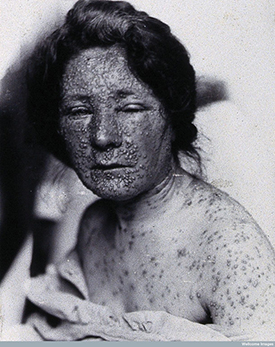
Smallpox produced a painful, unsightly rash on the face, arms, and legs of its victims. (Photo: Wellcome Library, London)
CURWOOD: Interesting. So, 1721, Boston has this horrible encounter with smallpox. What set off this particular epidemic?
COSS: Well, Boston ... it's funny Boston got smallpox almost like clockwork, about every 12 years they’d get a new epidemic. In this case, though, it had been almost 20 years since they had gotten smallpox. When smallpox did return in 1721, there were many many more people who were vulnerable to it and it became the worst outbreak that they’d ever had. The way it came into Boston was on board a British warship called HMS Seahorse. Now, Boston did have provisions for quarantine and there's an island in Boston Harbor - still there, a beautiful park now called Spectacle Island. Spectacle Island in 1721 was what was called the pest house and that was the quarantine station. But the British Navy was not obliged to follow the rules, basically, and so a somewhat arrogant captain came in the Boston Harbor realizing that he had picked up smallpox in Barbados where a very bad epidemic was raging. He came in and hid the fact that his ship was infected and slowly but surely it began to spread in the town.
CURWOOD: At the same time, of course, there's a lot of tension in Boston with the British occupiers so the crown is really being challenged for control of this particular colony. So how does this fever come together with the American Revolution as you postulate in your book?

A British ship carried smallpox into Boston (seen in the distance) in 1721. (Photo: Joseph F. W. Des Barres, Boston, as seen between Castle Williams and Governor’s Is- land, distant 4 miles . . . (Detail). Map image courtesy of the Norman B. Leventhal
Map Center at the Boston Public Library).
COSS: Well, there are several ways. I mean, the most direct connection I think is that the smallpox epidemic ended up becoming a leverage point or a point of contention between the royal Governor, who represented Britain obviously, and the elected House of Representatives which had been really flexing its muscle. This had been going on for several years and their relationship was quite contentious and it was quite dysfunctional, and in fact, one of the reasons smallpox got out of control is that there was so much dysfunction at the political level that they were unable to work together to nip it in the bud, so to speak.
CURWOOD: And then this guy Cotton Mather, who has this horrible reputation from the Salem witch trials, starts talking about dealing with the smallpox epidemic with, well, it doesn't sound exactly like the nicest thing to do: to slice your skin and drop in pus from somebody who’s got smallpox.
COSS: Well, no one thought it was a really good idea at first except that Zabdiel Boylston, the one doctor who matter convinced to try the experiment, and the reason Boylston tried it, by the way, was because he had grown up outside of Boston. His father was a doctor who had traveled a lot to the countryside and had a lot of interaction with Native Americans, so he was predisposed towards listening to ideas that came away from the mainstream. It was so counterintuitive to give somebody a disease to save them from a disease. The outrage was just enormous. Both Boylston and Mather, their lives were threatened. In fact, at one point, someone did throw a bomb through Cotton Mather's bedroom window. So it was very volatile.
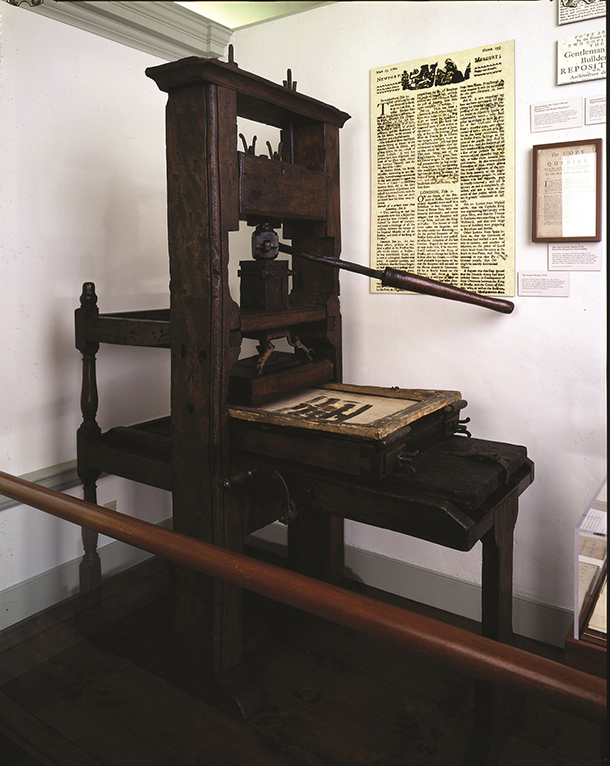
Benjamin Franklin helped his brother James print The New-England Courant using this printing press. (Photo: Newport Historical Society)
CURWOOD: And you also write in your book, Steven, that in this horrific scene emerges the first really free American press. How does this connect to the outbreak of smallpox and the unpopularity of the colonial governor?
COSS: Well, what happened was there was a young man named James Franklin and that last name will be familiar to you and to everybody else who is listening because he was the older brother of Benjamin Franklin. Well, in 1721, James Franklin started a newspaper called the New England Courant and that would become the first independent newspaper in America which meant that he published it without asking permission or trying to please the royal authority with what he printed. When smallpox came along he decided, “Aha I've got this wedge issue, I got this controversial thing. I can jump on this by being anti-inoculation actually.” He jumped on the popular side of of the debate and then once having done that he did turn it to things that he was really interested in, which was politics and social issues and humor, and that's what he did.
CURWOOD: So what you're telling me is the birth of the free press in America is tied to an entrepreneur who went into business to prey on the fears of the public.
COSS: In essence I am. [LAUGHS]
CURWOOD: This newspaper that got started by James Franklin. What was the flavor and tenor of that, and what analogies to today might you make about this publication?
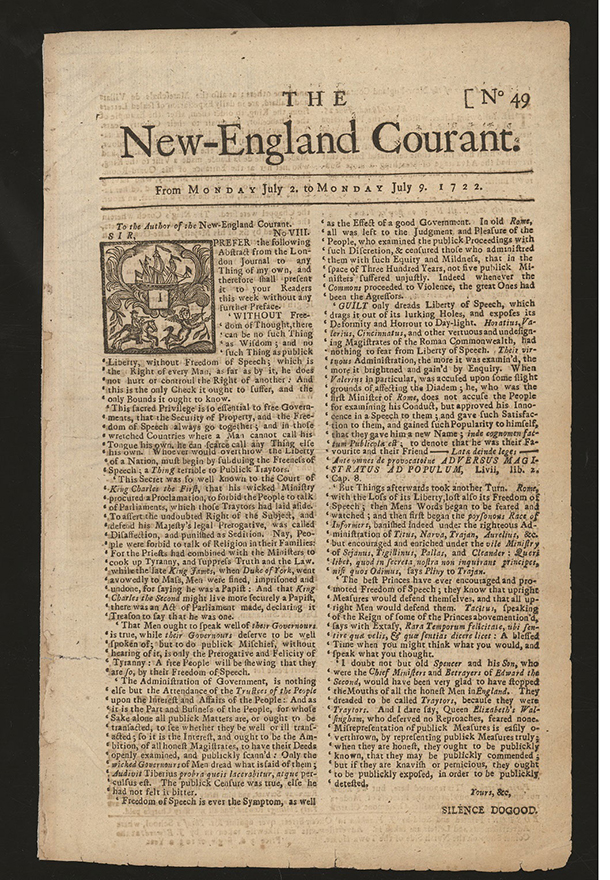
A page from the New-England Courant (Photo: Collection of the Massachusetts Historical Society)
COSS: It was interesting because as I said it covered a lot of serious ground. Before the New England Current, nobody would ever dare report an election result, believe it or not. The government was the only one who could decide whether people should know who won the election for representative to the House, the Massachusetts House. It was also very racy and it was also funny. In fact, I think you can draw a straight line from things like The Daily Show or the Colbert Report or The Onion. Benjamin Franklin made his debut as a writer in this newspaper as Silence Dogood, a name which many people might know. And Silence Dogood wrote kind of humorous articles that poked fun at Harvard, that poked fun at prostitution, that poked fun at drinking, and, mind you this is in puritan Boston in 1721. These are not people who are generally known to have had a great sense of humor about anything.
CURWOOD: At the same time in the same town you have a Ben Franklin working on this newspaper with his older brother. How did that work out?
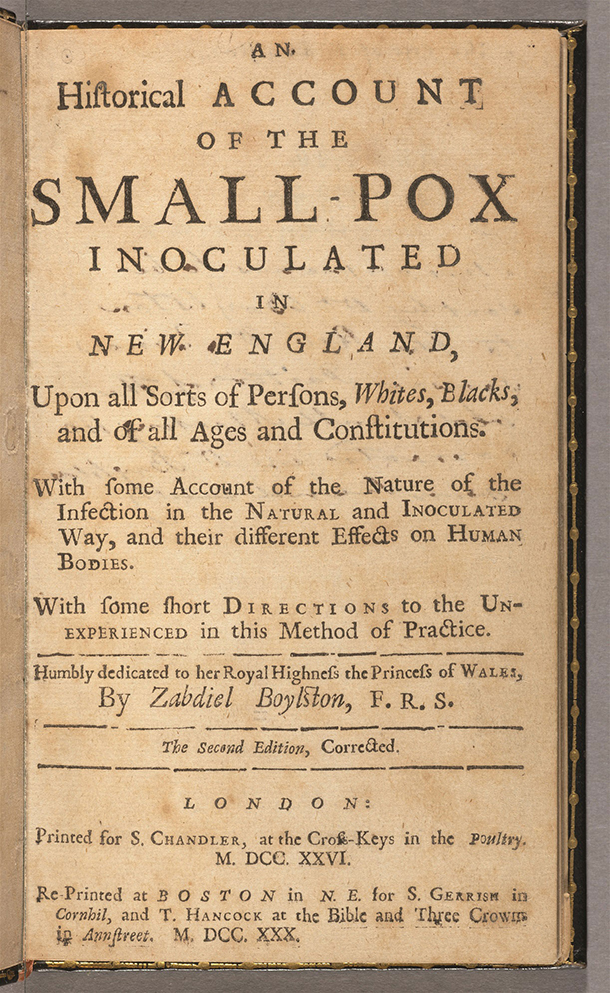
In 1724 Zabdiel Boylston published his account of smallpox inoculation in New England. (Photo: EC7.B6988.B730e, Houghton Library, Harvard University)
COSS: Yeah, I say, only half kidding, that in 1721 everything Ben Franklin ever really needed to know he learned, that year, because the experience of working with his brother in that town at that period with those challenges really changed the way he thought about politics, about the press and freedom of the press. Obviously he saw what his brother was doing. He saw Boylston conduct this experiment which was important for Franklin in two ways. One was it was the first real experiment that Benjamin Franklin the great experimenter had ever witnessed firsthand and it also made Boylston a hero, and Boylston like Franklin was a man of humble origins. He didn't have a Harvard College education like most of the other doctors in town. He didn't come from a prominent family or a wealthy family, and I think Ben Franklin walked away from this experience realizing the potential of his own life in a lot of different ways.
CURWOOD: So, now that we've told this part of the story, let's bring this together. How does smallpox and the media come to, as you put forward in your book, really in some respects start the American Revolution, start that ball rolling?
COSS: Well, there are really two strains there. I think there's the role that smallpox had in exacerbating what was already a really interesting political rebellion by a man named Elisha Cooke who I consider sort of our founding grandfather. He was the guy behind all of the political opposition to Great Britain. When smallpox came along and became sort of a wedge issue for the politicians, what it did was really amp up that fever, that political fever. So that's one way for sure, and Elisha Cooke's party which would become known as the Boston Caucus actually came to fruition around 1721 and started a few years earlier, and from 1721 on to 1776, it was the mechanism and the infrastructure for the American revolution. Meanwhile, you’ve got James Franklin and the whole freedom of the press thing and you've got someone for the first time in American history actually saying that the press ought to have a right to criticize the government.
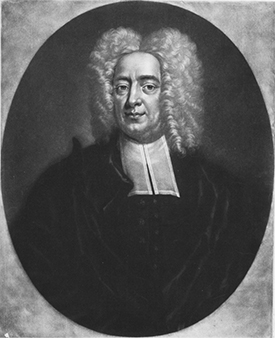
Cotton Mather was a leading Boston minister in the early 1700s and learned of the practice of inoculation from his slave, Onesimus. (Photo: Peter Pelham, Cotton Mather. Courtesy of the American Antiquarian Society)
CURWOOD: Let's digress for a moment from 1721 to 1776 and smallpox again and the role that Ben Franklin played at that time.
COSS: Yes sure, sure. Well, Ben Franklin, largely because of this went, as we all know, to Philadelphia, and in Philadelphia he became a huge proponent of inoculation, arguably the number one proponent of inoculation in all of the colonies, and because of that Philadelphia became the center of inoculation. Jefferson went there to be inoculated. Many people were inoculated there. Benjamin Franklin, because he believed in inoculation, also kind of nurtured a new generation of physicians who were pro-inoculation and in fact both of the men who advised George Washington, once he became Commander in Chief of the Army, strongly pro-inoculation, and in 1777 George Washington made the really daring decision to have his entire army inoculated. A lot of historians believe that maybe the greatest thing Washington ever did as General in the revolution was inoculate his army.
CURWOOD: One of the interesting reflections that I came away from your book with, Steven, is a sense of déjà vu in the current climate discussion, the inability of the policymakers to really deal with it. There are many things about this and in fact really climate change could be seen as a public health issue. How crazy am I to look as that as an analogy?
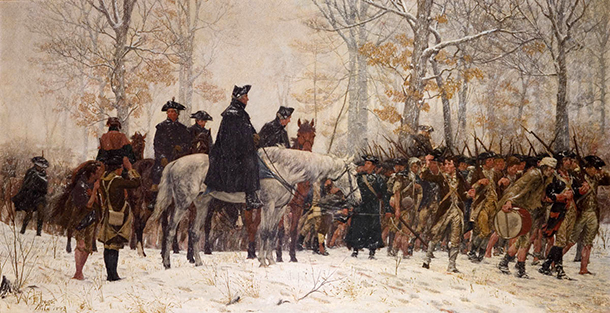
President George Washington’s decision to inoculate the Continental Army very likely helped the American colonies win the Revolutionary War. (Photo: painting by William B. T. Trego, “The March to Valley Forge,” public domain)
COSS: I don't think that's crazy at all. I hadn't thought of that but I see a lot of similarities. You know, I think what we saw in Boston that ties to, not only today but all through history since and probably before, is a sense of the pull between public health and money to be honest with you. I mean, it's interesting. In 1721 Boston with the third busiest seaport in the entire British Empire, so the idea of a smallpox epidemic was fearsome, not only because of the health implications, but also the financial implications. Smallpox comes to Boston, Boston gets embargoed by its trading partners and the economy goes down the drain, and I think the officials in Boston had an opportunity to act early on in a way that might've minimized the spread of the smallpox and ultimately prevented an embargo which did happen eventually. So the worst expectation of the leaders in Boston relative to an embargo ended up happening, and sometimes I think that in a lot of cases including climate change, including some other contagious diseases for that matter, you see that it's not so much that we don't have the knowledge or the technology to stop something. We seem to lack the political will because of issues that have to do with profit.
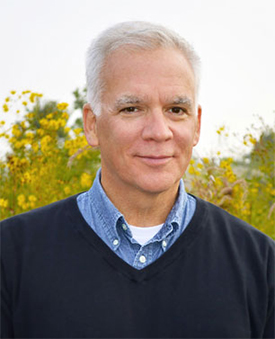
Stephen Coss.(Photo: courtesy of Stephen Coss)
CURWOOD: Steven Coss's book is called "The Fever of 1721: The Epidemic That Revolutionized Medicine and American Politics". Thanks so much for setting the time today, Steven.
COSS: You're welcome Steve, thank you.
[MUSIC: Dudu Maia, “Didi E Gonzaga,” Dudu Maia, Pixinguinha/Bonodito Lacerda, Dudu Maia Records]
CURWOOD: Next time on Living on Earth, how farming helps veterans deal with Post Traumatic Stress disorder.
JACKSON: Animals don’t care about your bad day. They’re going to come up and they’re like, ‘I want you to pet me.’ You’re like, ‘OK, but I’m feeling really mad right now, but man, they don’t know the amazing stuff they do for our vets who come through.
CURWOOD: The power of goat and pig therapy for vets. That’s next time, on Living on Earth.
Links
The New-England Courant and the Smallpox Inoculation Controversy
Boston Globe: “How an African slave helped Boston fight smallpox”
Living on Earth wants to hear from you!
Living on Earth
62 Calef Highway, Suite 212
Lee, NH 03861
Telephone: 617-287-4121
E-mail: comments@loe.org
Newsletter [Click here]
Donate to Living on Earth!
Living on Earth is an independent media program and relies entirely on contributions from listeners and institutions supporting public service. Please donate now to preserve an independent environmental voice.
NewsletterLiving on Earth offers a weekly delivery of the show's rundown to your mailbox. Sign up for our newsletter today!
 Sailors For The Sea: Be the change you want to sea.
Sailors For The Sea: Be the change you want to sea.
 The Grantham Foundation for the Protection of the Environment: Committed to protecting and improving the health of the global environment.
The Grantham Foundation for the Protection of the Environment: Committed to protecting and improving the health of the global environment.
 Contribute to Living on Earth and receive, as our gift to you, an archival print of one of Mark Seth Lender's extraordinary wildlife photographs. Follow the link to see Mark's current collection of photographs.
Contribute to Living on Earth and receive, as our gift to you, an archival print of one of Mark Seth Lender's extraordinary wildlife photographs. Follow the link to see Mark's current collection of photographs.
 Buy a signed copy of Mark Seth Lender's book Smeagull the Seagull & support Living on Earth
Buy a signed copy of Mark Seth Lender's book Smeagull the Seagull & support Living on Earth

